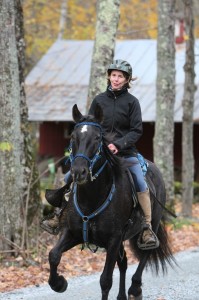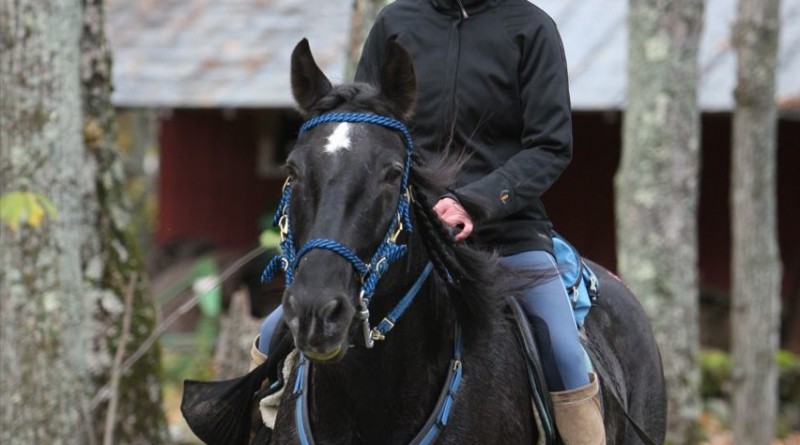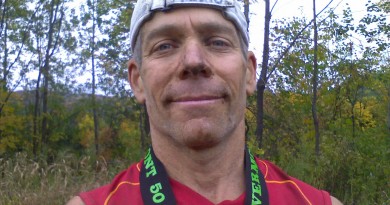Kathleen Hobart | Reader Athlete Nov. 2011
 Kathleen Hobart
Kathleen Hobart
Age: 59
Residence: Belvidere
Family: Husband, Geoff; son, Ryan, 34; daughter, Heather, 37; two grandchildren aged 1 and 4
Occupation: Clerk of the Vermont Superior Court, Lamoille Unit
Primary sport: Equestrian distance riding
VS: Can you explain to us what distance riding is?
KH: There are actually two kinds of distance riding: endurance riding and competitive trail riding. Endurance riding is just racing. I’d like to do more of that, but there aren’t many races in Vermont. Competitive trail riding is quite different. All horses start with 100 points. The goal is to have your horse come back in as good a shape as when it left. You have to go before a licensed veterinarian and a “tack” or lay judge. The vet looks at the horse’s metabolic condition and the tack judge makes sure that whatever the horse is wearing (saddle, breast plate, etc.) isn’t causing abrasions. You’re not competing against the next horse; you’re looking out for your horse. You learn a lot about their digestive system, hydration, gut motility, etc. You have to really know your horse.
VS: Are there competitive trail rides in Vermont?
KH: There is a wonderful race that the Green Mountain Horse Association runs out of Woodstock in September. I’ve done the 60-mile distance twice and the100-mile distance twice. This year, I wasn’t able to compete because the grounds in Woodstock sustained significant damage from Tropical Storm Irene. It was a huge disappointment, but when I think about what people down there went through, I have to count my blessings.
VS: Is that 100 miles in one day?
KH: No, the GMHA is a three-day ride with 40 miles the first and second days, and 20 miles on the third day. There are some 100-mile rides that take place over the course of a single day, but Molly doesn’t have the body type to do that.
VS: Tell us about Molly.
KH: I call her my horse of a lifetime. I’ve owned lots of horses, and some of them were really great, but Molly is unique. You can ride her in company or alone, and she’s happy. Horses are prey animals, so when a horse sees another horse running, they think that horse is afraid, and they should be afraid too, so they run. Many horses don’t drink enough at water stops on trail runs because when another horse leaves, they take off as well and don’t properly hydrate. Molly doesn’t do that. However, Molly’s body type isn’t suited for endurance running. She’s heavily bodied, so it’s quite a challenge for me to make sure she has the right amount and balance of electrolytes.
VS: How did you get her?
KH: Amazingly, I got her off the Internet, long before I knew anything else about endurance riding. I had a draft pony, and I wanted to make a team, and I saw her picture. She’s a Dales Pony, which is a British breed that I knew nothing about, but when the seller sent me a video, I knew I had to have her. I bought her in the fall when she was 5, and I started conditioning her the next spring. She did her first ride that year and got all As. We didn’t win because she was green, and I didn’t want to push her. She’s 14 now and in the prime of her life. She won the 60-mile race in Woodstock, and the following year, she won the rookie division in the 100-miler. She won “best condition” at a 30-mile endurance race last year.
VS: How much time do you get to spend with Molly?
KH: I try to ride twice a week after work. On weekends, I’ll typically do five- to six-hour rides, starting slowly in the spring and working up to longer rides later in the summer. We ride from mid-April to the end of October. She’s a horse that really loves to move, and I’ve got a lot of property, so she can run on her own. It’s a challenge to find the balance with a full-time job and family.
VS: What other sports do you do?
KH: I was a competitive body builder for four years in my 40s, competing in Vermont, but not out of state. I tend to be kind of obsessive about things, and I wanted to get in shape, so I was weight training all the time, and that led to competitions. It was fun, but you’re constantly thinking about food, which isn’t healthy. It got me into resistance training, which is great for bone density, but otherwise, I don’t think it’s a particularly healthy sport. The plus side is I know how to weight train and not hurt myself. When I stopped competing in bodybuilding, I got into mountain biking and did that obsessively for awhile. I’d go out for a whole day by myself riding from Montgomery to Bakersfield, Waterville and back, but I had to cut back because the good mountain biking is in the summer when I need to be on my horse. In the winter, I snowshoe and run three to four times a week to get my heart going, but I wouldn’t call myself a runner.
VS:What makes horseback riding so great?
KH: It’s so magical to me that I don’t know how to describe it. I don’t do it for the ribbons, but because I’m absolutely passionate about my horse. Something happens when you get on the back of a horse that is absolutely indescribable. Molly just loves to sprint, and when I let her go, which is often, I don’t even have contact with her mouth; I just hang on to her mane and all you can hear is the wind in your ears and her breathing. There’s nothing I can compare it to except holding my grandchildren for the first time.


